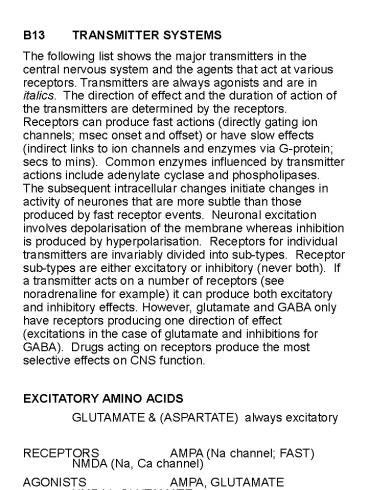B13 TRANSMITTER SYSTEMS - PowerPoint PPT Presentation
1 / 4
Title: B13 TRANSMITTER SYSTEMS
1
- B13 TRANSMITTER SYSTEMS
- The following list shows the major transmitters
in the central nervous system and the agents that
act at various receptors. Transmitters are always
agonists and are in italics. The direction of
effect and the duration of action of the
transmitters are determined by the receptors.
Receptors can produce fast actions (directly
gating ion channels msec onset and offset) or
have slow effects (indirect links to ion channels
and enzymes via G-protein secs to mins). Common
enzymes influenced by transmitter actions include
adenylate cyclase and phospholipases. The
subsequent intracellular changes initiate changes
in activity of neurones that are more subtle than
those produced by fast receptor events. Neuronal
excitation involves depolarisation of the
membrane whereas inhibition is produced by
hyperpolarisation. Receptors for individual
transmitters are invariably divided into
sub-types. Receptor sub-types are either
excitatory or inhibitory (never both). If a
transmitter acts on a number of receptors (see
noradrenaline for example) it can produce both
excitatory and inhibitory effects. However,
glutamate and GABA only have receptors producing
one direction of effect (excitations in the case
of glutamate and inhibitions for GABA). Drugs
acting on receptors produce the most selective
effects on CNS function. - EXCITATORY AMINO ACIDS
- GLUTAMATE (ASPARTATE) always excitatory
- RECEPTORS AMPA (Na channel FAST) NMDA (Na, Ca
channel) - AGONISTS AMPA, GLUTAMATE NMDA, GLUTAMATE
- ANTAGONISTS NBQX MK-801
- KETAMINE
- the NMDA receptor also has glycine as a coagonist
and many regulatory sites. There are also
kainate and metabotropic receptors for the
excitatory amino-acids. There are reasonably
selective drugs for the former (often found at
pre-synaptic sites) and a great deal of confusion
about the latter family of slow receptors. - INHIBITORY AMINO ACIDS
- GABA always inhibitory
- RECEPTORS GABA (Cl channel FAST) GABAB (K/Ca
channel SLOW) - There is also a GABAC receptor insensitive to
bicuculline - AGONISTS GABA, MUSCIMOL GABA
- (BENZODIAZEPINES) BACLOFEN
- (BARBITURATES)
2
ACETYLCHOLINE (ACH) RECEPTORS MUSCARINIC
MUSCARINIC NICOTINIC M1, 3, 5 (SLOW) M2 and 4
(SLOW) (FAST) EXCITATORY INHIBITORY
EXCITATORY
AGONISTS ACh, MUSCARINE ACh, NICOTINE There are
a number of antagonists for the muscarinic
receptors. The nicotinic receptors can be
separated into muscle and neuronal variants
selective drugs for the latter have been
described (ABT compounds) MONOAMINES
NORADRENALINE (NA) RECEPTORS ALPHA-1 (A, B
and C) ALPH-2 (A, B and C) EXCITATORY
INHIBITORY AGONISTS NA NA,
CLONIDINE ANTAGONISTS PRAZOSIN YOHIMBINE,
ATIPAMAZOLE There ar also Beta receptors
DOPAMINE (DA) RECEPTORS D-1, 5 D-2, 3,
4 (INHIBITORY) INHIBITORY AGONISTS DA,
BROMOCRIPTINE (L-DOPA) (AMPHETAMINE RELEASES
DA) ANTAGONISTS HALOPERIDOL CHLORPROMAZINE DO
MPERIDONE 5-HYDROXYTRYPTAMINE (5HT) RECEPTORS
5HT-1 5HT-2 5HT-3 also 4-7 INHIBITORY BOTH
EXCITATORY AGONISTS 8OHDPAT ANTAGONISTS
sumatriptan ketanserin ondansetron WAY
100635 PEPTIDES Peptides are long chains of
amino-acids (3-25) and so are much larger than
glutamate, GABA etc. All receptos are G-protein
linked and slow. OPIOIDS inhibitory RECEPTOR
S MU DELTA KAPPA ORL1 AGONISTS
ENDORPHIN ENKEPHALIN DYNORPHIN
NOCICEPTIN MORPHINE DPDPE U69599 ANTAGONIST NA
LOXONE AT ALL 3 RECEPTORS
3
There are many other peptide transmitters such as
the TACHKININS, excitatory RECEPTORS NK1 NK2
NK3 SUBSTANCE P NEUROKININ B NEUROKININ A
There are many other less well characterized
peptide transmitters.Furthermore, ATP,
adenosine, nitric oxide, prostanoids and several
other chemicals also function as neurone to
neurone communicators. Ion channels can also be
drug targets the therapeutic effects of Na
channel block by local anaesthetics and
anticonvulsants can be noted. A Na channel
specific for sensory neurones has been found.
In addition, the influx of calcium into neurones
can activate enzymes and regulate gene
expression. L, N and P type channels can be
characterized, the latter by selective toxins.
Neurones often contain multiple transmitters.
Neuronal phentypes can alter either as a result
of pathology or transmitter actions.
GABAA ALPHA2 OPIOID DA ME/4 5HT1
GABAB ALPHA2 OPIOID DA M2/4 5HT1
GABAA GLYCINE
Fast inhibitions
KAINATE
AMPA NMDA AINATE NICO 5HT3
fast excitations
ALPHA1 M1/3/5 NEUROKININ 5HT2/4
slow excitations
4
Transport processing
Precursor
.. .. ...
Synthesis
autorecptors
Breakdown ..
release
release
.
..
..
Reuptake
Breakdown in synapse
Slow Receptor events
fast
slow
Glutamate, GABA Noradrenaline, Dopamine, 5HT,
Acetylcholine
Peptides (entephalins)
Ion channel
Transmitter binding sites
membrane
GABA B, NORADR, DOPAMINE, PEPTIDES SLOW 7TM
RECEPTOR
AMPA, NMDA, GABA A 5HT3 NICOTINIC FAST ION
CHANNEL RECEPTORS































